Table of Contents
The term “bounce rate” means the percentage of visitors who leave your website after visiting a single page.
Bounce rates can vary widely, from 26%–70%, or even higher depending on your industry, but high bounce rates are not always a bad thing. Much depends on the type of page your visitors are arriving at, as well as your goals for the page.
Today we cover what bounce rate is, how to calculate it, and what to do when it’s preventing you from reaching your marketing goals.
What is the bounce rate? Definition of bounce, bounce rate
A bounce is when a visitor goes to a single page on your website and “bounces” away, which means they don’t go to another page on your website. Usually, this means they return to the SERP.
This is important because your performance in organic search results can be affected by the bounce rate. Higher bounce rates are, in general, an indication that something is wrong with your content, and in most cases, your goal should be to find ways to lower your bounce rates for important pages.
What causes a bounce depends on many factors, including what kind of content visitors are looking at. For example, a visitor might hit that back button on an ecommerce landing page if they decide not to make a purchase.
They might also bounce from such a landing page if they don’t get the information they need about the product from your content, or they might bounce because they think the price is too high, or because they can’t tell from your images if the product is what they’re looking for.
They might even bounce if the product doesn’t have reviews on the page (or if the reviews aren’t great or are negative) or if the call to action (CTA) isn’t compelling enough.
In this case, the bounce is correlated directly with your conversion rate. If people are bouncing away, you’re not making sales. You’ll need to figure out what’s causing the bounces and try to fix it (more on this later).
Bounces can vary depending on the content visitors are viewing
For other types of content, like a blog post, a bounce might actually be a good thing.
For example, if the user inputs a search query and finds the exact answer they’re looking for, they might feel no need to go deeper into your website. The blog post has satisfied their search intent — what they’re looking for when they input a search query.
In this example, your average bounce rate may be above 90%. If your goal is to educate with a blog page, then a high bounce rate is expected.
The same might be said for a video or a podcast. In these cases, you’d likely be more worried about average time on page or dwell time.
On the other hand, if dwell time is low and the bounce rate is high, the blogger might have a problem.
It might indicate that users aren’t satisfied, and they’re bouncing away after a low session duration because the content doesn’t satisfy search intent.
In this case, you’ll need to better optimize your content for searchers to lower the bounce rate. Otherwise, they’ll return to the search engine and click through competitor content until they find what they’re looking for.
Other factors can affect bounce rate
Bounces aren’t just caused by your content. Here are several other factors that can cause visitors to bounce.
- Pages load slowly
- Internal links aren’t effective at moving visitors to other pages
- Website isn’t mobile-friendly
- Calls to action aren’t effective
- Pop-ups are intrusive or excessive
- Title tags/meta descriptions don’t accurately match your content
- The website has a poor user experience
Fortunately, these can all be solved to minimize bounce rates and maximize visitors’ chances of viewing other pages on your website.
How bounce rate is calculated
If a bounce is when a user goes from your website and then leaves without going deeper into your website, bounce rate is the percentage of people who bounce compared to the total number of visitors to a page.
You can both calculate an average bounce rate for an entire website and bounce rate for specific pages.
There’s another metric that’s similar to bounce rate and can be a little confusing — exit rate.
Your exit rate shows the percentage of people who exit a page regardless of how many pages they viewed previously.
For example, someone could come to your home page, then go to a blog post, click an internal link to another blog post, then exit your website.
This wouldn’t be considered a bounce because they went to 3 different pages, but that last page is their exit page.
If you calculated the exit rate for that page, then it would include that user.
The image shows how to calculate both bounce rate and exit rate:

Viewing bounce rate in Google Analytics
Google Analytics is a handy tool for learning about bounce rates on your website. It calculates your site-wide and your page-specific bounce rates for you automatically.
In Google Analytics, your average bounce rate for your entire website can be found on behavior overview:

If you navigate to site content > all pages, you can see your bounce rates for individual pages. You can then compare bounce rates for all the different pages on your website:
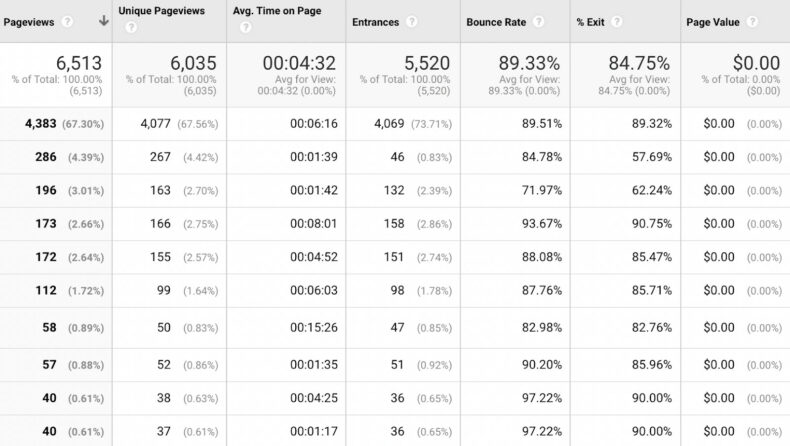
If you want to compare bounce rates by other factors, like your users’ location, age, sex, etc., you’ll need to add a secondary dimension on this page:
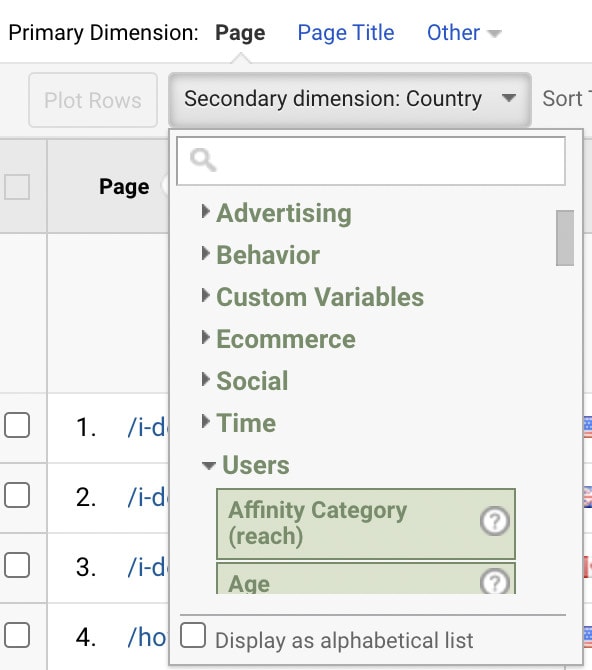
Once you’ve done this, it will break out pages by the chosen dimension, and then you can see how the bounce rates differ by that dimension.
For example, you could look at how bounce rates differ by country:
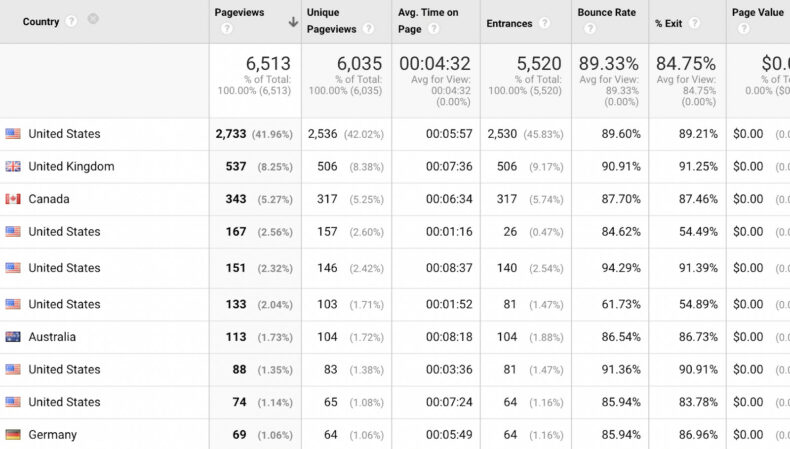
Try other dimensions that are important to your business. For example, if you have a high bounce rate in Germany and you are targeting users in that country, you might want to look at how you can improve that page for your German users.
Is bounce rate an SEO ranking factor?
A low bounce rate is correlated with first-page rankings on Google:
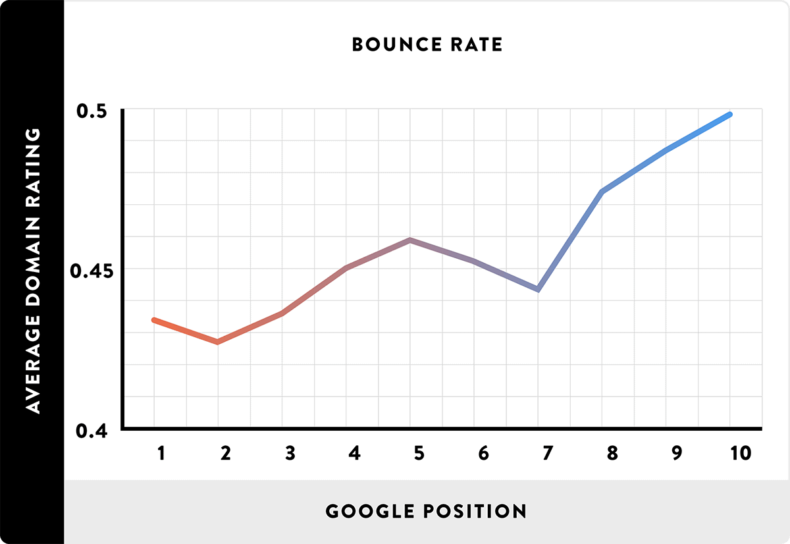
However, it’s unlikely that bounce rate is a ranking factor.
Because bounce rates vary widely by industry and by the type of page in question, it wouldn’t be reasonable for Google to consider a page with a high bounce rate as poor-quality.
What matters most in SEO is the quality of your content, the number of backlinks to that content, and usability factors, like page load speed.
So no, bounce rate is not likely a ranking factor, but it can be an indicator of other problems on your web page that might be causing users to leave without consuming your content or taking action.
What is a good bounce rate?
A good bounce rate depends on several factors.
First, it varies significantly by industry. While a 40% bounce rate might be horrible for one industry, it might be incredible for another.
Second, and more importantly, it depends on the content itself.
For example, a blog post might have a high bounce rate if users find what they need and then leave, while your homepage might have a low bounce rate because users are often moving from that page to another page on your website.
Here are some factors to consider.
Bounce rate industry averages
Bounce rates vary by industry. Here’s some data on average bounce rates:

Note that the difference between industries can be significant. This is why it’s so important to understand that bounce rates vary so much — just because you think your bounce rate is high, that doesn’t mean it’s actually too high.
You’ll want to set your own benchmarks for bounce rates for your own website. You can start with industry averages, but remember that these are just averages.
It’s better to focus on your averages, then see what you can do to decrease your own bounce rates, and perhaps more importantly, to get the content to perform the way you want it to, whether that be increasing page views, increasing conversion rates, or even just increasing views of a video on that page.
How to reduce a high bounce rate
Several methods can reduce a high bounce. If you’ve determined that your bounce rate is too high, here’s where you can start.
Satisfy search intent
Among the most important ranking factors in the Google search algorithm is how well your content matches what searchers are looking for — this is called satisfying search intent.
Visitors will bounce if you’re not delivering exactly what they’re looking for.
Search intent is so crucial that content from a website with low domain authority and few backlinks can still potentially outrank content from a website with much higher domain authority and more backlinks if the content better satisfies the search intent of the searcher. Content matters.
Example 1
If visitors come to your website expecting to learn about how to put in a fence post in your yard, and they get a low-quality article that doesn’t include a list of materials they need or show how they work, they’ll likely bounce away.
However, if they get an informative blog post that has a video demonstrating how to use a post hole digger along with examples, images, and explanations of what to do after digging the hole and why to do it, they’ll be more likely to stay on the page, and potentially even visit another.
Example 2
The same might be said for a product page.
If the user gets all the information they need about the product, including product specs, features, reviews, images, and explanations of how it works alongside benefits, they might make a purchase right then and there, reducing your bounce rate.
That being said, it’s important to remember that satisfying search intent can sometimes fail to reduce bounce rate. This is because users might get all the information they need and not want to dig further into the website.
In this case, a high bounce rate might indicate that search intent is being satisfied properly. You might not have to make any changes to get the most out of that page. You have to ask yourself: What are people here for? And if that reason involves viewing only one page, your high bounce rate is likely fine.
Improve page speed
Many factors can affect page load times, and these can keep visitors from ever seeing your content in the first place. And when they abandon your page before even seeing your content, it’s still considered a bounce.
The time period between when a user clicks on a search engine result and actually gets to your page can cause your bounce rate averages to skyrocket. In fact, if your website takes more than 2 seconds to load, the bounce rate can get exponentially higher with each second. Even 2 seconds isn’t fast enough for some users:
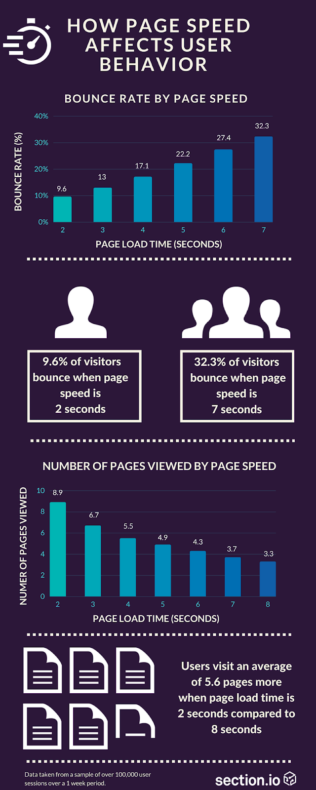
There are several ways you can improve page speed, including:
- Changing your host
- Enabling image compression
- Enabling Gzip
- Minifying your code
- Reducing redirects
- Removing render-blocking JavaScript
- Using a caching plugin
- Using a CDN (content delivery network)
Use effective internal linking
If a user comes to a page on your website and doesn’t have a simple way to navigate to other pages on your website, the chances that they’ll bounce are much higher. That’s why you need to use effective internal linking.
Internal links help users to learn more about the content on your website. They can be links to other pages on your website — for example, links to products.
They can also be links to blog posts. For example, you might have a blog post on how to put keywords into a page, and then you might include an internal link to a page where they can learn more about SEO.
Your internal links can also come in the form of CTAs at the end of your content. For example, you might refer users to your “consulting” page for a free SEO audit or a landing page for a downloadable ebook on the subject they just read about in a blog post.
If you have no internal links, or if you have internal links that aren’t useful to the user, then they’re going to be unlikely to click them to go deeper into your website (and so your bounce rate will remain high).
Use CTAs to guide visitors to other pages
As mentioned above, CTAs in your content are an important part of getting users to go deeper into your website.
CTAs can come at the end of a blog post, for example, to get users to learn more about the topic that you’ve written about.
They’re also critical parts of product/services pages as they invite users to make a purchase or contact you from another page. Perhaps you want users to contact you to set up a demo, but they need to go to another page to do so.
Using CTAs in your content can get users closer to a purchase and keep your bounce rates down by encouraging users to move on to the next step in the funnel you’ve created for them.
You’ll want to A/B test your CTAs to see how well they perform. For example, changing the text of a button might lead to a higher conversion rate (and a lower bounce rate).
You’ll also want to consider the placement of the CTAs. For example, you might want to have CTAs spread throughout a blog post instead of only at the end of the blog post.
On a landing page, you might want to use lower barrier CTAs than “purchase now” spread throughout the page, like “learn more” or “schedule a demo.”
Improve mobile-friendliness
After Google crawls your website, it will index the mobile version of your site first.
That means your website needs to be mobile-friendly if you want Google to index it and show it to your customers. Mobile traffic accounts for more than 50% of traffic worldwide, so it’s not something you can afford to ignore.
Mobile-friendliness is a major effector of bounce rate. It’s a matter of usability.
If users are coming to your website on their mobile device and seeing tiny text that’s too hard to read or images that don’t fit on the screen, they’re going to struggle to consume your content, and they won’t want to deal with the hassle of pinching to zoom or repeatedly poking their screens to try and hit a small button. That means they’ll probably bounce.
Most content management systems (CMSs), like SquareSpace or WordPress, will automatically be mobile-friendly. It’s unlikely you’ll need to do anything to most modern websites to ensure they’re mobile-friendly.
However, it’s still a good idea to check your website’s mobile-friendliness using Google’s Mobile-Friendly Test, especially if it was designed a long time ago or it’s a custom website.
Test and optimize calls to action
A/B testing your calls to action is a critical component of determining why a site’s bounce rate might be higher than you’d want it to be (or why a specific page has a high bounce rate compared to the rest of your website).
A/B testing (also called split-testing) is when you create two different versions of a web page to test how changes to that web page affect metrics like conversion rate or bounce rate. The goal is to discover which version performs better.
“A” in A/B refers to your control page or the page that you don’t change. “B” refers to a variant of the page. You can create many different B pages to test everything from a change to a CTA to different images or videos or even blocks of text.
Pages A and B are shown to the same number of random visitors. The goal is to test a representative sample. As the test progresses, you track how the changes applied to the B page affect the metric you’re trying to change.
After the test, if A performs better, you might perform another A/B test to see if an additional change improves the metric you’re trying to improve. You do this until you feel you’ve optimized your content as best you can.
An example of A/B testing
For example, you can try two different methods of lead generation on a page. If on page A you want to see if users will respond by making a phone call, your CTA would say “call now” and include a phone number to call.
In the B version of the page, the CTA would say “fill out the form” and include a form for the user to fill out.
Depending on the metric you’re interested in improving (in this case, the form of lead generation that’s most effective), you can then track that metric to see if page A or page B works better.
In this example, the reason could be that “call now” along with a phone number is something your readers aren’t willing to do yet. They may not want to call you at all.
However, asking them to fill out a form might be a lower barrier to entry for them that increases user engagement and leads to a higher conversion rate.
To reach your digital marketing goals, test your most important pages on your website, like your product pages and other key landing pages. As long as you have the resources, you can test as many times and as often as you are able.
Get help with your bounce rate
Need help lowering your bounce rate? Talk to a proven SEO consultant.
Remove / optimize pop-ups
Sometimes, improving your bounce rate and reducing single-page sessions has more to do with your website itself and less to do with your content.
Sometimes it’s just a problem with the user experience, which can be affected heavily by intrusive elements like pop-ups.
Most users will agree that pop-ups — especially pop-ups that happen in the wrong place or at the wrong time — are annoying at best and spammy at worst.
You might find that your pageviews drop significantly if you add a pop-up to your website that is hard to close, for example, or if they show up repeatedly from the moment you reach the page.
That being said, pop-ups do convert:
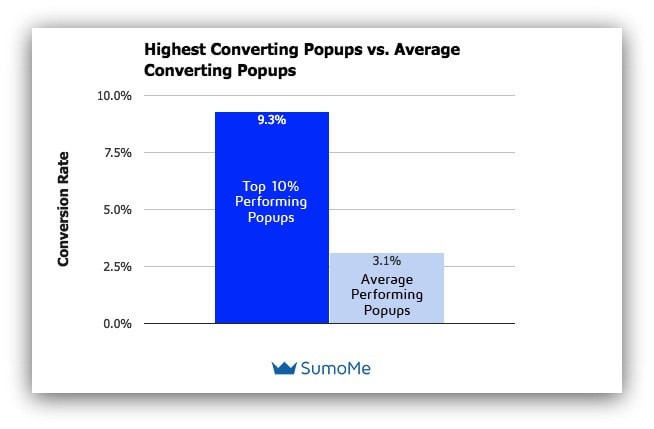
As you see in the graphic, top-performing pop-ups can have a high conversion rate, so optimizing your pop-ups is critical to ensuring they don’t negatively affect your page visits.
To optimize them, you might need to do some A/B testing. See if a pop-up that invites a user to follow you on social media, for example, works better if you wait for 2 minutes before deploying it, so they’ve had time to read your content and determine if you’re someone they want to hear from again.
If your highest bounce rate for a page is when the pop-up triggers immediately, that’s a sign the pop-up is potentially causing your high bounce rate.
Ensure your title tag and meta description match the content
When users end up on a SERP, there are usually only a few pieces of data that they can see — the title tag and the meta description:
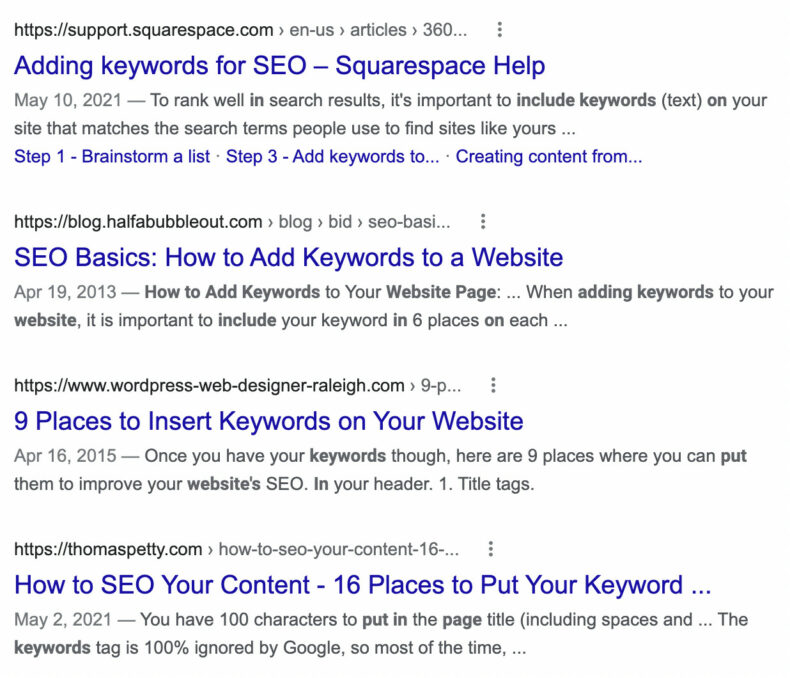
The text in blue is the title tag. It needs to be between 55 and 60 characters long, and it needs to include your target keywords. It should also be compelling and interesting enough that a user will want to click on it.
If a user sees a title tag and clicks on the search result, only to find out that your content doesn’t match up with their search intent, they’re likely going to bounce away.
The other piece of content that users are going to see is the meta description. It should be between 155 and 165 characters long and should include the targeted keyword phrase. It should also be informative and help users better understand what they’ll see on the page they click through to.
If it doesn’t do all this, users might feel like they’ve been tricked because the content wasn’t as advertised.
If that’s the case, they’re going to bounce away. Always make sure that your content matches the title and the meta description as closely as possible so that users will get the content they’re looking for (and therefore be more likely to stay on your website).
Optimize other user-experience factors
To maintain a low bounce rate, you need a user-friendly website. If you’ve implemented all the suggestions above, you’ve already done a lot to improve the user experience.
However, other factors can cause higher bounce rates that marketers and SEOs might not even consider because they’re so simple, including:
- Text size
- Menu layout
- Intrusive sidebars
Other user experience factors include the layout of the menu. If your menu is confusing, or if the content they’re looking for is hard to find, then your website might have a bad bounce rate because your visitors are confused.
Sidebars can similarly lead to a poor user experience. On some websites, when they’re viewed on a mobile device, the sidebar will be pushed to the top of the screen. Users then have to scroll past the entire sidebar before getting to the content.
This might confuse your visitors. They might think they’ve gotten to the wrong page and never scroll down to read your site’s content.
Usability matters, so have multiple people test out your website on various devices if your website’s bounce rate is higher than you’d like it to be.
Get a complimentary SEO audit
If you work hard to reduce your overall bounce rate, you have a better chance of generating more visitors, leads, and sales to hit your marketing goals.
Just remember, a good bounce rate ultimately depends on your industry, the performance of your individual pages, and your own metrics and goals.
Want to see how you’re doing with SEO? Get an instant SEO audit below. Or, schedule a free consultation to see how intent SEO can boost search traffic revenue by 700%.
